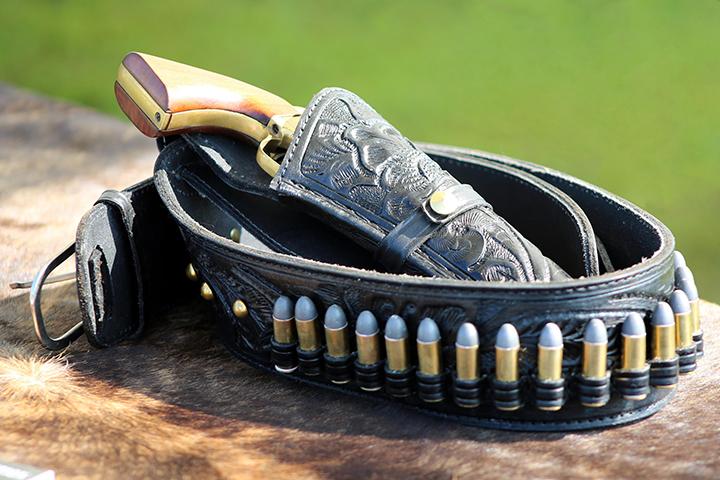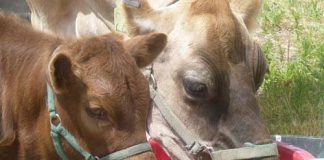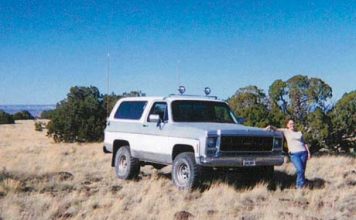 |
|
| Issue #69 • May/June, 2001 |
One good thing about being out in the boonies by yourself is that you can carry a gun on your own property. It’s a fundamental right that, for a lot of people, just makes a statement. Quite frankly, it can also be a pretty good idea. The trick is doing it comfortably and, when necessary, discreetly.
The rabid fox or skunk is coming toward your dog. The rifle is in the house, and you’re out here with the problem. Are you going to be able to access that gun and do what needs to be done in time to keep the deadly disease from being transferred to the pet that loves you? Not bloody likely. Can you solve the problem if there’s a good handgun at your hip? You bet.
 There’s a place for shoulder holsters. On Y2K night, (12/31/99), author reports to work with one issue Ruger .45 in his issue uniform holster, and another in a shoulder rig that will hide under his patrol jacket. Neither had to be called upon. |
Maybe the problem for you is snakes. Or, in certain parts of America, bears. Or, in other parts of America, creatures that walk on two legs and think the movie “Deliverance” was a training film. The point is, when you need a gun, you generally need it now.
There are many good reasons why the firearm is a working tool on a working farm or ranch. The problem might be a predator, or it might be livestock that runs amok. Legendary gun expert Elmer Keith was a working cowhand. Many a time his powerful sixgun saved him from being dragged to death by an out of control horse, or gored or trampled by an enraged steer. His protégé Ross Seyfried, one of today’s top experts on firearms and their use afield, carried a 4-inch .44 Magnum when he was working a cattle ranch, and always had a heavy revolver on his belt when guiding hunters on safari in the African bush.
The trick of wearing the gun all the time is getting comfortable with it. Comfort means different things to different people. For editor Dave Duffy, carrying a gun in a hip holster was literally a pain in the butt. He found a shoulder holster that fit him. Suddenly, it was as if the gun wasn’t there anymore.
I know people who’ve had the reverse experience. For them, even the finest shoulder holster felt like an ill-fitting brassiere, but they quickly grew accustomed to a hip holster.
First, understand that wearing a gun is something you’ll need to get used to. Remember when you got your first wallet or purse? You felt like a wallet or purse with a little kid attached. But, after you got used to having it on, it seemed to disappear. The final stage of acceptance was when you realized you felt uncomfortable when it wasn’t there. It’s the same with carrying a handgun all the time.
 Glock 21, a lightweight .45 that holds 14 rounds with pre-ban magazines, can ride comfortably all day in this accessible, concealable hip holster by High Noon. |
Second, understand that carrying a gun requires a system. A cheap holster will hang out away from you, its weight pulling against your body, constantly and annoyingly reminding you of its presence. Holsters are like shoes: the watchword is, buy quality. The comfort will pay for the added price, long before you reap the dividend of the better product lasting longer.
I can’t tell you how many people I’ve seen show up at my gun classes with expensive guns in cheap holsters. Nor how many I’ve seen with good guns in good holsters, attached to crappy belts whose institutional memory must have been the words, “Attention, K-Mart Shoppers.”
In the same sense that the knee bone is connected to the thigh bone and all of that, the gun is connected to the holster and the holster is connected to the belt. You wouldn’t buy a Volvo to keep your family safe, and then outfit it with two-ply retread tires to save money. Believe me, a $200 traded-in .357 police service revolver, in a $100 holster on a $50 mated dress gun belt, will be a far more comfortable and effective combination than a $3,000 custom .45 automatic in a $15 nylon holster on a floppy, narrow belt.
 Author’s department issue P90 and Safariland SS-III duty holster ride comfortably on orthopedically cut Milt Sparks duty belt. Other equipment includes spare magazines, SureFire flashlight carrier, handcuff case, and latex gloves. |
My police department issues us a fine gun and a fine holster, and leaves the rest of our leather up to us. My Ruger .45 automatic rides in a Safariland 070 state-of-the-art duty holster, with an orthopedic curve that keeps it from chafing the hip. My duty belt was custom made by Milt Sparks Leather, also orthopedically curved, and even though I’m kind of old and decrepit for road patrol, I can do two back to back shifts wearing it with all the heavy equipment and not feel discomfort. That’s how important the belt is.
I’m off duty as I write this. On my hip is a Glock 30, a lightweight, compact, 11-shot .45 automatic. The inside the waistband holster and the belt are by Mitch Rosen Extraordinary Gunleather, sold through our pro shop at Armor of NH, PO Box 122, Concord, NH 03302. It feels like it isn’t there.
Part of that is habituation: I’m used to wearing it. Part of it is that, since I usually wear a holstered gun inside my waistband (it conceals better that way) most of my trousers including the ones I’m wearing are two inches large in the waist. The gun is an intrusive presence on your body. You have to adapt to it.
Get a good holster and a good belt of the proper width. Strap on the gun. Wear it for a week, from when you dress in the morning to when you undress for the final time at night. After that week, you’ll find your body is acclimating to having the gun on, and all of a sudden, it’s not an inconvenience anymore. It’ll be like the wallet or the purse. You’ll know you’ve “arrived” when you realize you’re uncomfortable when you’re not wearing it.
Welcome to the wonderful world of the armed, safe, free American citizen, living responsibly in a backwoods home.














